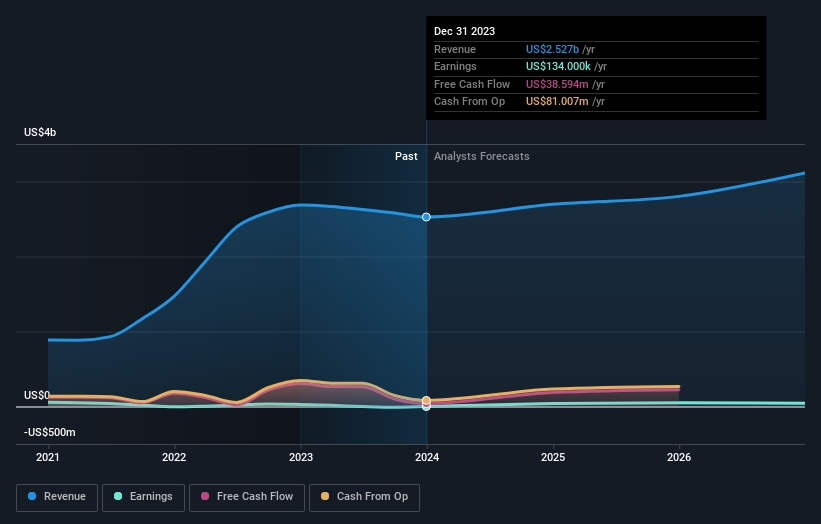US$7.07: That's What Analysts Think Stagwell Inc. (NASDAQ:STGW) Is Worth After Its Latest Results
One of the biggest stories of last week was how Stagwell Inc. (NASDAQ:STGW) shares plunged 23% in the week since its latest yearly results, closing yesterday at US$5.34. Results were overall in line with expectations, with the company breaking even at the statutory earnings per share (EPS) level on US$2.5b in revenue. Earnings are an important time for investors, as they can track a company's performance, look at what the analysts are forecasting for next year, and see if there's been a change in sentiment towards the company. With this in mind, we've gathered the latest statutory forecasts to see what the analysts are expecting for next year.
View our latest analysis for Stagwell
Taking into account the latest results, the consensus forecast from Stagwell's six analysts is for revenues of US$2.70b in 2024. This reflects a credible 6.7% improvement in revenue compared to the last 12 months. Statutory earnings per share are predicted to bounce 35,560% to US$0.39. Before this earnings report, the analysts had been forecasting revenues of US$2.78b and earnings per share (EPS) of US$0.44 in 2024. From this we can that sentiment has definitely become more bearish after the latest results, leading to lower revenue forecasts and a substantial drop in earnings per share estimates.
The consensus price target fell 7.3% to US$7.07, with the weaker earnings outlook clearly leading valuation estimates. There's another way to think about price targets though, and that's to look at the range of price targets put forward by analysts, because a wide range of estimates could suggest a diverse view on possible outcomes for the business. Currently, the most bullish analyst values Stagwell at US$9.00 per share, while the most bearish prices it at US$5.50. There are definitely some different views on the stock, but the range of estimates is not wide enough as to imply that the situation is unforecastable, in our view.
These estimates are interesting, but it can be useful to paint some more broad strokes when seeing how forecasts compare, both to the Stagwell's past performance and to peers in the same industry. It's pretty clear that there is an expectation that Stagwell's revenue growth will slow down substantially, with revenues to the end of 2024 expected to display 6.7% growth on an annualised basis. This is compared to a historical growth rate of 34% over the past five years. Juxtapose this against the other companies in the industry with analyst coverage, which are forecast to grow their revenues (in aggregate) 3.6% per year. So it's pretty clear that, while Stagwell's revenue growth is expected to slow, it's still expected to grow faster than the industry itself.
The Bottom Line
The most important thing to take away is that the analysts downgraded their earnings per share estimates, showing that there has been a clear decline in sentiment following these results. They also downgraded Stagwell's revenue estimates, but industry data suggests that it is expected to grow faster than the wider industry. The consensus price target fell measurably, with the analysts seemingly not reassured by the latest results, leading to a lower estimate of Stagwell's future valuation.
Following on from that line of thought, we think that the long-term prospects of the business are much more relevant than next year's earnings. At Simply Wall St, we have a full range of analyst estimates for Stagwell going out to 2026, and you can see them free on our platform here..
However, before you get too enthused, we've discovered 3 warning signs for Stagwell (1 shouldn't be ignored!) that you should be aware of.
Have feedback on this article? Concerned about the content? Get in touch with us directly. Alternatively, email editorial-team (at) simplywallst.com.
This article by Simply Wall St is general in nature. We provide commentary based on historical data and analyst forecasts only using an unbiased methodology and our articles are not intended to be financial advice. It does not constitute a recommendation to buy or sell any stock, and does not take account of your objectives, or your financial situation. We aim to bring you long-term focused analysis driven by fundamental data. Note that our analysis may not factor in the latest price-sensitive company announcements or qualitative material. Simply Wall St has no position in any stocks mentioned.

